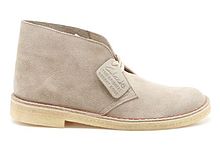
Chukka boots (/ˈtʃʌkə/) are ankle-high leather boots with suede or leather uppers, leather, wooden or rubber soles, and open lacing, with two or three pairs of eyelets. The name chukka possibly comes from the game of polo, where a chukka is a period of play.
Generally, "chukka boot" refers to a form of desert boots originally worn by British soldiers in the Western Desert Campaign of World War II.
Materials and style
Chukkas are usually made from calfskin or suede, although they can be made from other materials. The style first became popular in the late 1940s through the 1960s as casual wear. In the 21st century, chukkas persist as a popular menswear shoe, particularly in the United Kingdom. They can be worn with both suits and more casual wear like jeans.
According to shoe historian June Swann, the essential chukka boot is ankle-high, open-laced, and unlined, with two to four pairs of eyelets, thin leather soles, calfskin suede uppers in two parts (each from a single piece of leather; quarters sewn on top of vamp), and rounded toes.


Desert boot
"Desert boot" redirects here. For other uses, see Desert combat boot.
A desert boot is a chukka boot with crepe rubber soles and, typically, suede uppers. Desert boots were popularized in the 1950s by UK shoe company C. & J. Clark.
Desert boots were officially introduced to the world with the debut of the Clarks' Desert Boot at the 1949 Chicago Shoe Fair. After feature coverage in Esquire magazine, their popularity took off. According to Clarks, inspiration came from "the crepe-soled, rough suede boots made in Cairo's Khan el-Khalili bazaar for British Eighth Army officers."
These boots were based on the South African veldskoen which became a popular footwear item in Southern Africa due to their robust and simple design. Often being bought by soldiers for use in the various bush wars of the region, they have become popular across the world as "desert boots".
The year was 1941, and the soldier, well he wasn't just any infantryman, he was Nathan Clark, and he'd been sent to war with two missions. First and foremost to protect his country, and, secondly, to discover some new shoe designs for his family's company. As a member of the Eighth Army, Clark had been deployed to Burma, and it was here that he noticed that the officers in his formation were wearing these strange, sand colored chukkas during their downtime. Clark investigated the shoes and learned that they had originally been commissioned to Cairo cobblers by South African soldiers whose old-military issue boots had failed them out on the desert terrain. They wanted something that was both lightweight and grippy which led to creation of a boot with a suede upper on a crepe sole.
— Jake Gallagher, GQ, August 15, 2012
See also
References
- "Chukka". Merriam-webster.com. Retrieved 16 January 2015. (NB In pronunciation keys, Misplaced Pages uses the phonemic-/ʌ/ convention while Merriam uses the stressed-/ə/ convention).
- ^ Durkin Matthes, Betsy (2006). Dressing the Man You Love. Peter's Pride Publishing. pp. 259. ISBN 0-9773878-3-6.
- ^ Woolnough, Richard (2008-01-01). The A to Z Book of Menswear. Bermuda: Bespoke Solutions. p. 72. ISBN 978-1-897403-25-9.
- Johnston, Mark (2007). The Australian Army in World War II. Osprey Publishing. p. 54. ISBN 978-1-84603-123-6.
- "Charity, and Crocodile Chukka Boots". The New York Times. November 30, 1988..
- Miles, Shirley (1989). American Costume, 1915–1970: A Source Book for the Stage Costumer. Indiana University Press. p. 186. ISBN 0-253-20543-3.
- Joan Nunn (1 January 2000), Fashion in Costume, 1200-2000, Rowman & Littlefield, p. 221, ISBN 978-1-56663-279-9
- Plummer, Todd (October 24, 2014), "A Guide to the Best Men's Boots", The Wall Street Journal
- Deleon, Jian (October 9, 2013), "Meet the Everlasting Pair of Desert Boots", GQ.com
- Schneider, Sven Raphael (18 November 2013). "The Chukka Boots Guide". Gentleman's Gazette. Retrieved 2 February 2015.
- Rickett, Oscar (27 August 2014). "Chukka boots – an enduring favourite for mods, polo players and casuals alike". The Guardian. Retrieved 1 February 2015.
- Velskoen , pronounced 'fell-skoon' and known colloquially as 'vellies,' are the ancestor of the modern-day desert boot. They were first made in the 1600s by members of the Dutch East India Co., inspired by the footwear of the Khoisan tribe. Currently, in South Africa and Namibia, vellies are worn by people from all walks of life especially, laborers, bush rangers, and university students. —Herbert Schier Velskoen (sic) Desert Boots and "Relatively unknown outside of Africa, the velskoen—pronounced 'fell-skoon' and known colloquially as 'vellies'—are actually the ancestor of the modern day desert boot. —Brother Vellies Archived 2015-05-18 at the Wayback Machine
- Gallagher, Jake (August 15, 2012). "Dropping Knowledge: The Desert Boot". GQ.